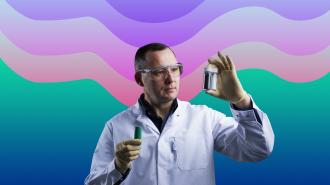An inexpensive, environmentally friendly technique for lithium recycling could help ensure we have enough of the valuable metal to power the clean energy future — if it works as well in the real world as it does in the lab.
The challenge: Transitioning to electric vehicles (EVs) is a key part of combating climate change, and because lithium-ion batteries can store a lot of energy for their size, they’re our best option (so far) for powering them.
The lithium needed to create those batteries is a finite resource, though, and mining it is environmentally destructive. Demand for lithium extends beyond EVs, too, as lithium-ion batteries are used in laptops, smartphones, and even TVs.
“This method … enables inexpensive, energy-efficient, and environmentally compatible recycling.”
Oleksandr Dolotko
Lithium recycling: While we can extract lithium and other useful metals from old batteries after they die, the standard recycling process is expensive, inefficient, and requires extreme heat or corrosive chemicals. It’s one reason why the vast majority of lithium batteries still don’t get recycled, and many end up in landfills.
Researchers at the Karlsruhe Institute of Technology (KIT) have developed a new lithium recycling technique that works at low temperatures, without harsh chemicals.
“The method can be applied … for a large range of commercially available lithium-ion batteries,” said first author Oleksandr Dolotko. “It enables inexpensive, energy-efficient, and environmentally compatible recycling.”
How it works: The KIT team’s lithium recycling method starts with adding some aluminum foil to a batteries’ cathode and grinding it all up in a “ball mill” — a hollow, spinning cylinder containing balls that smash up whatever is in the container.
The mechanical force of the milling causes a chemical reaction between the aluminum and the cathode materials — though even the researchers aren’t exactly sure why.
“It is really hard to say how it happens,” Dolotko told Nature.
“One of the most challenging parts of the invention is finished – the technique works.”
Oleksandr Dolotko
After taking the ground up mixture out of the mill, they add hot water (194 F). When the water is evaporated off, lithium carbonate — a useful material that can be used to make new batteries — is left.
Using this process, the researchers say they were able to recover 70% of the lithium in the cathode materials, and it worked with the cathode materials found in a range of different lithium-ion batteries.
For comparison, some battery recycling companies in the US claim to recover 95%-98% of the critical materials from lithium-ion batteries.
The cold water: In their study, published in Communications Chemistry, the researchers attempted to remove lithium from the materials typically found in the cathodes of lithium-ion batteries — they didn’t actually start with used up battery cathodes, which might contain impurities.
However, they don’t believe those impurities would have much of an effect on the lithium recycling process.
“The discovered technology presented in this article can be applied to these materials without significant adjustments,” they wrote. “The reaction conditions and final recycling products are expected to be similar to the ones investigated in this work.”
The cathode is also just one part of a lithium-ion battery, and the authors concede that the recycling process might not work — or work as well — if we tried to just grind up entire batteries, meaning we’d still need the tedious step of breaking them down for recycling.
“These extra components, like a binder, graphitic anode, copper, or other additives or side products of the black mass preparation, might affect the mechanochemically-induced recycling process,” they write.
Looking ahead: The researchers are now focused on answering important questions that will determine whether their lithium recycling technique will be able to play a major role in shaping our clean energy future.
“Currently, we are taking part in two European consortia where this technology will be applied to industrially treated lithium-ion battery wastes, scaled up, and evaluated for its profitability and environmental impact,” said Dolotko.
“As inventors, we believe adopting this technology in the industry is real and achievable … One of the most challenging parts of the invention is finished – the technique works,” he continued. “Now it is time to bring it to another level, which is our next exciting step.”
We’d love to hear from you! If you have a comment about this article or if you have a tip for a future Freethink story, please email us at tips@freethink.com.
